I've been using Artic Silver 5 on CPU and I was going to switch to IC diamond. When I apply the Artic Silver 5 I usually apply a line down the center then lock the fan/heatsink in place. I let the pressure of the heatsink spread the paste and prevent air bubbles. I had read though that IC diamond is different. You put a pea size blob in the center of the CPU then turn on the computer without the heatsink for 10 minutes. This allows liquid in the paste to evaporate. Then you lock the heatsink in place and your done. My concern comes with turning on the computer without a heatsink. I really don't like that and it goes against everything I have ever learned, that is never run a computer without a fan/heatsink. So do you really need to do that and is it safe? This would be for an I5 2500k.
Applying IC Diamond
- Thread starter Slickrick214
- Start date
-
- Tags
- Video Games
You are using an out of date browser. It may not display this or other websites correctly.
You should upgrade or use an alternative browser.
You should upgrade or use an alternative browser.
mcnumpty23
Polypheme
10 minutes without the heatsink !!!
where did you read that?
heres the way to apply ic diamond--clearly says pea size blob then put the heatsink on then power up pc
http://innovationcooling.com/applicationinstructions.htm
where did you read that?
heres the way to apply ic diamond--clearly says pea size blob then put the heatsink on then power up pc
http://innovationcooling.com/applicationinstructions.htm
I had read that on a website but I cant remember where. If I remember right it said 5 to 10 minutes. I also saw it here on this YouTube video.
http://www.youtube.com/watch?v=2xA0FKzue4I
http://www.youtube.com/watch?v=2xA0FKzue4I
mcnumpty23
Polypheme
O I thought he said no heatsink. I could have sworn he said he was going to keep the computer on without the heatsink.
mcnumpty23
Polypheme
yes he said he would leave it 10 minutes with the heatsink off to allow whatever chemical thats in the ic
diamond to keep it from setting in the tube to evaporate--the chemical evaporates at room temperature--but no
he didnt say with the pc powered up
look at the case fan--its not spinning
diamond to keep it from setting in the tube to evaporate--the chemical evaporates at room temperature--but no
he didnt say with the pc powered up
look at the case fan--its not spinning
O ok that makes more sense and sounds a lot less dangerous. One more thing. You see the first picture on the IC website link you posted. In the background they have a "ruler" that gives mm measurements. Is there a place to buy that type of ruler. It looks like a good way to measure exact blob sizes.

mcnumpty23
Polypheme
cant say i have seen a ruler like that before--if you knew what the actual name was i am sure they will have one
cheap on ebay
but quite honestly its easy to do it without one -- if not sure do a trial run--put a pea size blob on--put the
heatsink on--then take the heatsink off to see the coverage
err on the side off a smaller amount till you see how it spreads
then clean it off and do it for real and vary the size off blob based on the coverage of your test run
cheap on ebay
but quite honestly its easy to do it without one -- if not sure do a trial run--put a pea size blob on--put the
heatsink on--then take the heatsink off to see the coverage
err on the side off a smaller amount till you see how it spreads
then clean it off and do it for real and vary the size off blob based on the coverage of your test run
delluser1
Splendid
Slickrick214 :
O ok that makes more sense and sounds a lot less dangerous. One more thing. You see the first picture on the IC website link you posted. In the background they have a "ruler" that gives mm measurements. Is there a place to buy that type of ruler. It looks like a good way to measure exact blob sizes.
http://www.innovationcooling.com/applicationisnstructions_files/5-5.JPG
http://www.innovationcooling.com/applicationisnstructions_files/5-5.JPG
It's a drill bit gauge, should be able to find it in any hardware store.
mcnumpty23
Polypheme
delluser1 :
It's a drill bit gauge, should be able to find it in any hardware store.
thanks--that made life easier--its hard to find something when you dont know what its called
under £3 on ebay
though still think its easy enough without one
mcnumpty23
Polypheme
facepalm---now i think about it theres one built in the lid of my toolbox that flips out
obviously i never use it--everything just gets put up with a 8mm bit and the same size rawl plug
obviously i never use it--everything just gets put up with a 8mm bit and the same size rawl plug
delluser1 :
It's a drill bit gauge, should be able to find it in any hardware store.
It's actually a draftsman's tool called a "circle template" .... it's from back in the "ole days" before AutoCAD when us engineer types drew plans with pencils and ink on vellum and mylar.
I got a half dozen of em that I bought in the late 60's
 ....very same one in fact.
....very same one in fact.http://www.draftingsteals.com/catalog-templates-circles.html
Not surprised that manufacturers are "relabeling" and trying to make a buck off the old product .... kudos to american ingenuity !
delluser1
Splendid
JackNaylorPE :
It's actually a draftsman's tool called a "circle template" .... it's from back in the "ole days" before AutoCAD when us engineer types drew plans with pencils and ink on vellum and mylar 
I got a half dozen of em that I bought in the late 60's ....very same one in fact.
....very same one in fact.

I got a half dozen of em that I bought in the late 60's
 ....very same one in fact.
....very same one in fact.
Won't argue , the one in my drawer says Drill Gauge on it.
PS; I was the guy in the field that had to work off those dwgs.
4Ryan6
Champion
Regarding IC Diamond, First off be extremely careful removing the compound especially since you're putting it on a 2500K with a 3 year warranty as the diamond will scratch your CPU heat spreader, with much circular motion cleaning it off.
Additionally to get the best cooling from the product takes 50+ clamping pounds of pressure, and some heat sinks do not apply that much pressure, so if you bought it thinking it would give killer results, not all results have been good.
Unfortunately you won't find that information at the IC Diamond website, but an internet search looking for cases of IC Diamond scratches heat spreader, Yields:
http://www.evga.com/forums/tm.aspx?m=695748&mpage=1
When the IC Diamond give away took place here at THGF a couple of us experienced the scratching for ourselves, myself included!
Just be careful with it, especially removing it!
Additionally to get the best cooling from the product takes 50+ clamping pounds of pressure, and some heat sinks do not apply that much pressure, so if you bought it thinking it would give killer results, not all results have been good.
Unfortunately you won't find that information at the IC Diamond website, but an internet search looking for cases of IC Diamond scratches heat spreader, Yields:
http://www.evga.com/forums/tm.aspx?m=695748&mpage=1
When the IC Diamond give away took place here at THGF a couple of us experienced the scratching for ourselves, myself included!
Just be careful with it, especially removing it!
I saw that. I wonder if a water block would apply enough pressure. Also what are the results with a GPU? Also is the etching bad, I mean does it void your warranty does it cause performance issues?
4Ryan6
Champion
Slickrick214 :
I saw that. I wonder if a water block would apply enough pressure. Also what are the results with a GPU? Also is the etching bad, I mean does it void your warranty does it cause performance issues?
The picture below is a P4 2.66mhz socket 478 before.

Using IC Diamond Compound and a Q-Tip for a 2 minute circular rubdown.

And the fastest lapping award goes to? IC Diamond! (Crowd Goes Wild)

Now what you are looking at I just did, with a Q-Tip and IC Diamond in 2 minutes.
Intel writing is completely gone and the warranty, if this CPU had one.
Not that you or anyone would do that to your new under warranty CPU, but just proving you can actually lap your CPU with IC Diamond.
What the heck! Below is 5 minutes of fingertip rubbing, you can see the copper beginning to show through in the area of the Q-Tip rubbing.

I was going to lap it all the way to full copper face and ran out of IC Diamond.

Thank for the info and photos 4ryan. Got to learn something today.
OP, I'm still old school. I like the more normal pastes, and spread them with a card. As thin as you can all over the IHS. That way you know there are no dead pockets. And yes, NEVER run a PC without its HSF.
OP, I'm still old school. I like the more normal pastes, and spread them with a card. As thin as you can all over the IHS. That way you know there are no dead pockets. And yes, NEVER run a PC without its HSF.
4Ryan6
Champion
To the OP, AS5 is still good thermal compound, it's long cure in time is what's turned most against it, because the newer compounds on the market don't require long cure in times, check out AS5's performance in the Thermal Roundup in my sig, and that was with only a 2hr set in time period.
4Ryan6
Champion
delluser1 :
Nice Ryan
Those photos look like my I7-930 did after that giveaway
Those photos look like my I7-930 did after that giveaway
Yeah I lost my CPU warranty on that give away, once IC Diamond has had time in place clamped under pressure on the CPU it is tough to get off, and not realizing what was happening by the time I discovered the damage it was too late.
4Ryan6
Champion
4745454b :
Thank for the info and photos 4ryan. Got to learn something today.
OP, I'm still old school. I like the more normal pastes, and spread them with a card. As thin as you can all over the IHS. That way you know there are no dead pockets. And yes, NEVER run a PC without its HSF.
OP, I'm still old school. I like the more normal pastes, and spread them with a card. As thin as you can all over the IHS. That way you know there are no dead pockets. And yes, NEVER run a PC without its HSF.
I'm old school too, you would love Timtronics Grey Ice 4200, it's covered in the Thermal Roundup and has become my favorite TIM above all the others, it spreads almost like the heat spreader is pulling it to itself, far different than a lot of compounds you have to work in place.
IC Diamond
Distinguished
I had posted posted some comments regarding these tests by on another thread here but has since been deleted. I would hope my comments here remain intact.
http://www.tomshardware.com/answers/id-1738434/avoid-diamond-thermal-compound.html#11832892
So to go on record we will add some detail here.
It is critical when devising any test that a serious effort is made to minimize bias and not construct the confines of the test around those biases, one should also be aware of physical limitations and stay within a set limit of parameters.
The idea of the importance of scientific method was impressed upon me at an early age in a rural grade school by a 5th grade teacher who was directed to instruct us on the dangers of smoking. She had one of the farm boys catch a pigeon and bring it into school where upon she placed a lit cigarette in its mouth, taped it shut and held her fingers over the poor birds nostrils, the bird lasted all of 10 seconds before it fell over dead.
The demonstration while dramatic with the background noise of the girls in the class crying obviously had nothing to do with the affects of long term smoking only that you could kill a pigeon in 10 seconds using this method.
The above test example by 4Ryan6 certainly falls outside the range of our recommended use and is not an unusual note by manufacturers to say USE ONLY AS DIRECTED.
For example you would not think that a manufacturer of a hemorrhoid crème would not have to put on the label that it should not be used as a toothpaste but evidently some % do hence the warning notice.
Extreme and or accelerated testing on products is generally an accepted practice but even so they must adhere to the physical limitation imposed by its intended use. Taking a thermal compound and testing it at 300 degrees C so it fails in seconds then claiming it does not work would be ignoring the design intent of the product and noted as a inadequate representation of what the product is capable of.
There were a number of anomalies noted in the posted test pictures but here we will focus on the more obvious ones so we repeated 4Ryan6 tests. And would like to note at this point all thermal compounds are lapping compounds by composition of aluminum oxide(what they make sandpaper out of and is the most commonly used abrasive) read any MSDS AS5, Shin Etsu, MX4 all contain these particles and so should be used with the same caution by following good shop practice on application and removal.
Modeling the 4Ryan6 test we start with a CPU cleaned with acetone to remove a 2 year old application of IC Diamond. Note no scratches or polishing
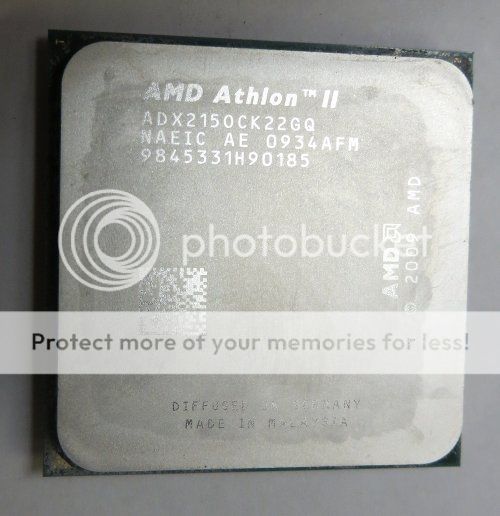
So using a Q-tip with light finger pressure we run into an immediate problem. The friction is so high that it pulls the cotton off the stick in about 5 seconds.
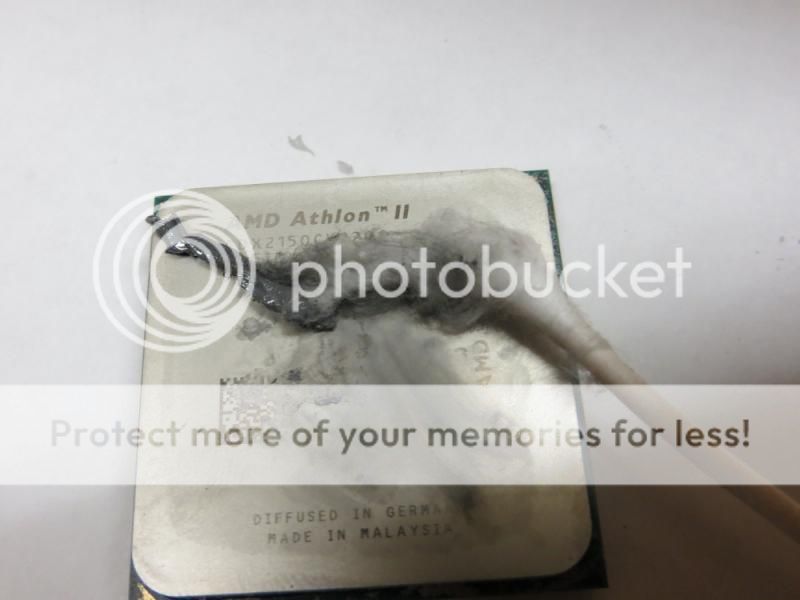
The only way to do this then is by placing a finger on the head of the Q-tip and pressing hard enough to overcome the friction drag. So the light finger pressure measured on a postal scale works out to be about 3lbs. And we end up with something like this.
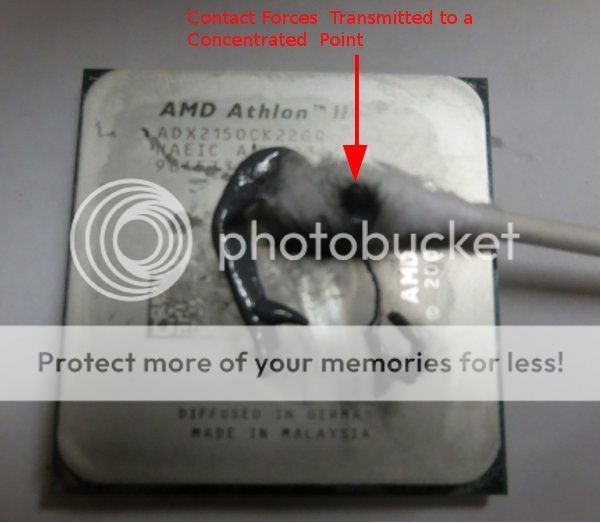
Note the 4mm Circular area where contact is made, this is basically the stick of the Q-tip– so 3 lbs. Light finger pressure(force), 4mm area is approximately 0.0062000124 sq inches, we can calculate the contact pressure here @ 3/0.0062000124 =483.87 PSI.
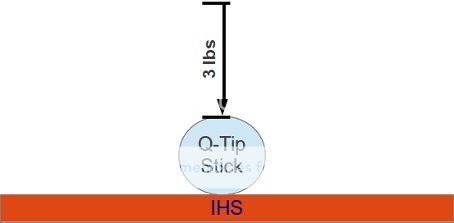
Essentially you are dealing with a segment of a circle as the contact point with 3 lbs of pressure concentrated on a minute area hence the 483 PSI
Now compare what would occur in an actual lapping situation.

As you can see here is a CPU on a postal scale with some 400 grit sandpaper. 7 PSI is probably what most would consider a high lapping pressure, much more pressure and the overall friction would create too much drag to smoothly move the piece.
CPU area 1.3 X 1.3 = 1.69 sq inches.
7/1.69= 4.14 lbs PSI
So here in 4Ryan6 demonstration example the application pressure is over 100X the pressure vs what one would see as actual lapping pressure all on a 1-2 micron thick soft ink stamped lettering. Not all that impressive when all factors are considered.
The drama in the presentation is relatively minimal when considering the physical factors involved, rather this is a case like where the pigeon died in the above opening statement.
Below is after over 2 hours of finger rubbing with IC Diamond and a cloth as the Q-tip fell apart after a few minutes. The effort here was to try and expose the copper under the nickel coating but we were unable to do so.
I would like to note that after 5 min we had a fairly good mirror polish and that finely textured finishes can easily be polished or scratched by materials much softer than the base material as the micro high spots are structurally weak and sensitive to forces that would otherwise have no effect if structurally supported.
An example here would be a .003 fine copper wire could be bent, broken with just a brush of a fingernail which is why a fingernail, cotton, wool, can easily scratch an aluminum or copper textured surface.

You can note from the result a pretty fine mirror polish with the reflected circuit board, particles are flour like and about 10 microns in size and left no visible scratches despite the effort.
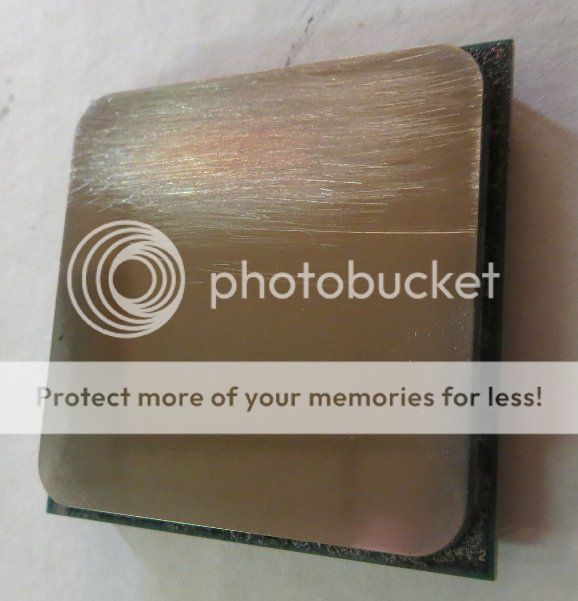
So after two hours and a fine mirror finish with no copper I took some 100 grit sandpaper and after about 20 seconds I had some visible copper.

At this point I would like to note two visible transitions in method as seen above.
1. There was a change from circular polishing to a horizontal abrasion left to right against the factory grain
2. There was also an obvious change in grit size at this point noted from deep scoring of the IHS surface that should have had more of a progression to a mirror finish at this point in my experience.
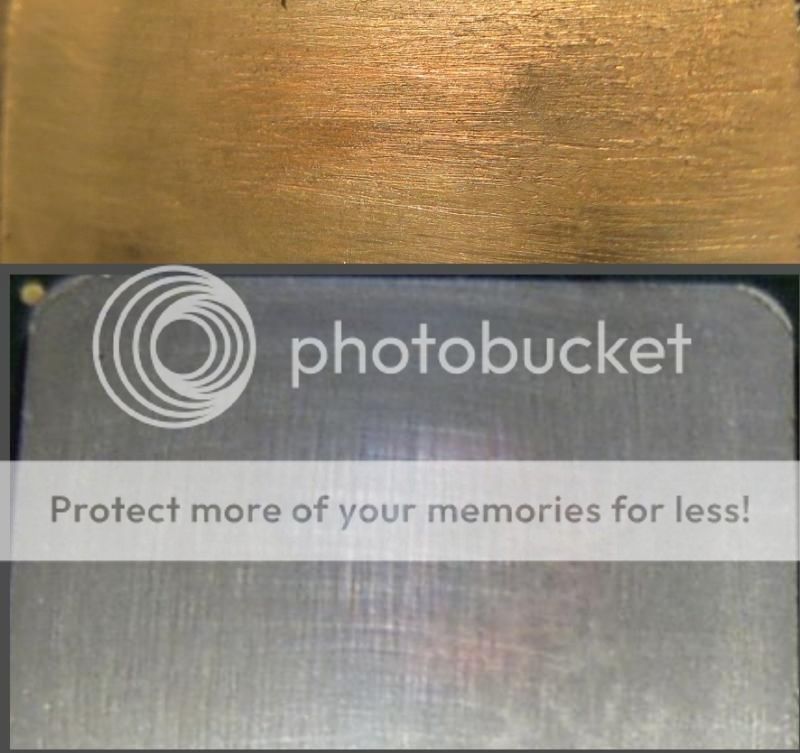
Above is a comparison of our 100 grit sand to remove the nickel plate and 4Ryan6 test example. Horizontal score marks are pretty much the same width and depth suggesting similar abrasive mediums and methods.

Our recommended removal method is to re-liquefy the compound with acetone then remove the compound in a single wipe or two. Our measured pressures on the postal scale which is accurate to +/- 0.1 lbs was 0.2 lbs. For this process.
You can do the math here 483lbs/ 0.2 lbs = 2415 that is 2415 times the pressure of our recommended removal procedure. Which can be found below.
http://innovationcooling.com/removal.html
Missconceptions Regarding Diamond Hardness
In the nomenclature of the abrasion trade when they say “diamond cuts better than anything else” what is really meant is that it lasts longer. In the abrasion literature nearly all specifications relate to movement, RPM, tool feed, heat the particle material can endure under friction etc. So the assertion that diamond cuts better than anything else in what is essentially a static non cutting application one would be attributing characteristics that do not apply to the application and removal of thermal compound.
Examples
Take two fingernail files of the same grit/particle size, one of diamond and the other aluminum oxide.
Now start filing fingernails at the same rate/speed and what you will soon note is that there is no difference in the amount cut. As far as what the fingernail “sees” is the same size abrasive particle that are both substantially harder than itself. Eventually the Aluminum oxide will star to wear but the diamond continues to cut at the same rate.
Another analogy would be the difference between a plastic knife and a steel knife cutting sticks of butter – both will cut at the same rate with all things being equal obviously long term perhaps in a month the plastic knife will start to show signs of wear while the steel knife lasts 10 years.
There is nothing magical about hardness, it is just an indicator of how long a material will last under the stress of machine tool work.
That being said all thermal compounds are lapping compounds by coincidence, not by intent. They are designed to be to be used as thermal compounds and adventures in lapping while interesting to some are only example of what not to do and the best practice here is to follow the manufacturers note to USE ONLY AS DIRECTED.
http://innovationcooling.com/removal.html
http://www.tomshardware.com/answers/id-1738434/avoid-diamond-thermal-compound.html#11832892
So to go on record we will add some detail here.
It is critical when devising any test that a serious effort is made to minimize bias and not construct the confines of the test around those biases, one should also be aware of physical limitations and stay within a set limit of parameters.
The idea of the importance of scientific method was impressed upon me at an early age in a rural grade school by a 5th grade teacher who was directed to instruct us on the dangers of smoking. She had one of the farm boys catch a pigeon and bring it into school where upon she placed a lit cigarette in its mouth, taped it shut and held her fingers over the poor birds nostrils, the bird lasted all of 10 seconds before it fell over dead.
The demonstration while dramatic with the background noise of the girls in the class crying obviously had nothing to do with the affects of long term smoking only that you could kill a pigeon in 10 seconds using this method.
The above test example by 4Ryan6 certainly falls outside the range of our recommended use and is not an unusual note by manufacturers to say USE ONLY AS DIRECTED.
For example you would not think that a manufacturer of a hemorrhoid crème would not have to put on the label that it should not be used as a toothpaste but evidently some % do hence the warning notice.
Extreme and or accelerated testing on products is generally an accepted practice but even so they must adhere to the physical limitation imposed by its intended use. Taking a thermal compound and testing it at 300 degrees C so it fails in seconds then claiming it does not work would be ignoring the design intent of the product and noted as a inadequate representation of what the product is capable of.
There were a number of anomalies noted in the posted test pictures but here we will focus on the more obvious ones so we repeated 4Ryan6 tests. And would like to note at this point all thermal compounds are lapping compounds by composition of aluminum oxide(what they make sandpaper out of and is the most commonly used abrasive) read any MSDS AS5, Shin Etsu, MX4 all contain these particles and so should be used with the same caution by following good shop practice on application and removal.
Modeling the 4Ryan6 test we start with a CPU cleaned with acetone to remove a 2 year old application of IC Diamond. Note no scratches or polishing

So using a Q-tip with light finger pressure we run into an immediate problem. The friction is so high that it pulls the cotton off the stick in about 5 seconds.

The only way to do this then is by placing a finger on the head of the Q-tip and pressing hard enough to overcome the friction drag. So the light finger pressure measured on a postal scale works out to be about 3lbs. And we end up with something like this.

Note the 4mm Circular area where contact is made, this is basically the stick of the Q-tip– so 3 lbs. Light finger pressure(force), 4mm area is approximately 0.0062000124 sq inches, we can calculate the contact pressure here @ 3/0.0062000124 =483.87 PSI.

Essentially you are dealing with a segment of a circle as the contact point with 3 lbs of pressure concentrated on a minute area hence the 483 PSI
Now compare what would occur in an actual lapping situation.

As you can see here is a CPU on a postal scale with some 400 grit sandpaper. 7 PSI is probably what most would consider a high lapping pressure, much more pressure and the overall friction would create too much drag to smoothly move the piece.
CPU area 1.3 X 1.3 = 1.69 sq inches.
7/1.69= 4.14 lbs PSI
So here in 4Ryan6 demonstration example the application pressure is over 100X the pressure vs what one would see as actual lapping pressure all on a 1-2 micron thick soft ink stamped lettering. Not all that impressive when all factors are considered.
The drama in the presentation is relatively minimal when considering the physical factors involved, rather this is a case like where the pigeon died in the above opening statement.
Below is after over 2 hours of finger rubbing with IC Diamond and a cloth as the Q-tip fell apart after a few minutes. The effort here was to try and expose the copper under the nickel coating but we were unable to do so.
I would like to note that after 5 min we had a fairly good mirror polish and that finely textured finishes can easily be polished or scratched by materials much softer than the base material as the micro high spots are structurally weak and sensitive to forces that would otherwise have no effect if structurally supported.
An example here would be a .003 fine copper wire could be bent, broken with just a brush of a fingernail which is why a fingernail, cotton, wool, can easily scratch an aluminum or copper textured surface.

You can note from the result a pretty fine mirror polish with the reflected circuit board, particles are flour like and about 10 microns in size and left no visible scratches despite the effort.

So after two hours and a fine mirror finish with no copper I took some 100 grit sandpaper and after about 20 seconds I had some visible copper.

At this point I would like to note two visible transitions in method as seen above.
1. There was a change from circular polishing to a horizontal abrasion left to right against the factory grain
2. There was also an obvious change in grit size at this point noted from deep scoring of the IHS surface that should have had more of a progression to a mirror finish at this point in my experience.

Above is a comparison of our 100 grit sand to remove the nickel plate and 4Ryan6 test example. Horizontal score marks are pretty much the same width and depth suggesting similar abrasive mediums and methods.

Our recommended removal method is to re-liquefy the compound with acetone then remove the compound in a single wipe or two. Our measured pressures on the postal scale which is accurate to +/- 0.1 lbs was 0.2 lbs. For this process.
You can do the math here 483lbs/ 0.2 lbs = 2415 that is 2415 times the pressure of our recommended removal procedure. Which can be found below.
http://innovationcooling.com/removal.html
Missconceptions Regarding Diamond Hardness
In the nomenclature of the abrasion trade when they say “diamond cuts better than anything else” what is really meant is that it lasts longer. In the abrasion literature nearly all specifications relate to movement, RPM, tool feed, heat the particle material can endure under friction etc. So the assertion that diamond cuts better than anything else in what is essentially a static non cutting application one would be attributing characteristics that do not apply to the application and removal of thermal compound.
Examples
Take two fingernail files of the same grit/particle size, one of diamond and the other aluminum oxide.
Now start filing fingernails at the same rate/speed and what you will soon note is that there is no difference in the amount cut. As far as what the fingernail “sees” is the same size abrasive particle that are both substantially harder than itself. Eventually the Aluminum oxide will star to wear but the diamond continues to cut at the same rate.
Another analogy would be the difference between a plastic knife and a steel knife cutting sticks of butter – both will cut at the same rate with all things being equal obviously long term perhaps in a month the plastic knife will start to show signs of wear while the steel knife lasts 10 years.
There is nothing magical about hardness, it is just an indicator of how long a material will last under the stress of machine tool work.
That being said all thermal compounds are lapping compounds by coincidence, not by intent. They are designed to be to be used as thermal compounds and adventures in lapping while interesting to some are only example of what not to do and the best practice here is to follow the manufacturers note to USE ONLY AS DIRECTED.
http://innovationcooling.com/removal.html
TRENDING THREADS
-
-
-
Question I have been stuck between NVMe and SATA SSD. What should I do now?
- Started by maniac2556
- Replies: 12
-
-
RTX 4070 vs RX 7900 GRE faceoff: Which mainstream graphics card is better?
- Started by Admin
- Replies: 70
-
News US sanctions transform China into legacy chip production juggernaut — production jumped 40% in Q1 2024
- Started by Admin
- Replies: 31
-
Question 1TB HDD 80% Fragmented, Windows 10 Optimise Drives Program Doesn't Help
- Started by sdfbvcxbf
- Replies: 7
Latest posts
-
Question "Ghost in the machine" random crashes that I can't figure out ?
- Latest: DSzymborski
-
-
-

Tom's Hardware is part of Future plc, an international media group and leading digital publisher. Visit our corporate site.
© Future Publishing Limited Quay House, The Ambury, Bath BA1 1UA. All rights reserved. England and Wales company registration number 2008885.

